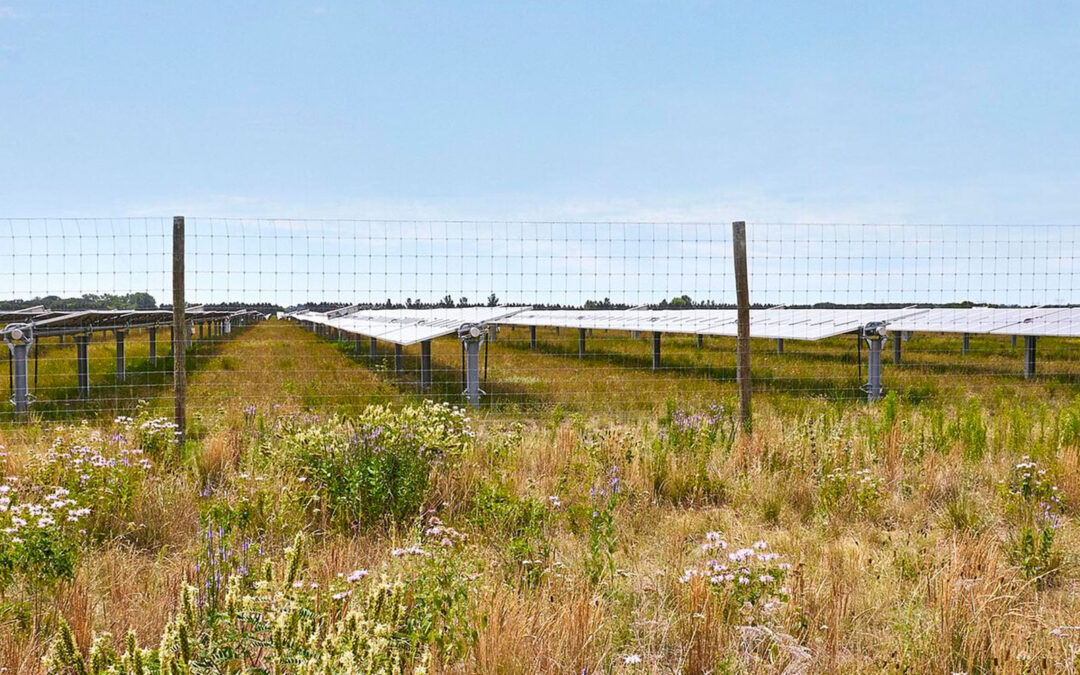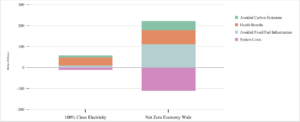
by Andrew Kell | Dec 27, 2022 | Electric Vehicles, Electrification, Energy Storage, Health, Netzero Wisconsin, Renewables, Solar, Wind
This past year, a Project Team consisting of RENEW Wisconsin, Clean Wisconsin, and GridLab commissioned Evolved Energy Research and Cambridge Econometrics to provide modeling, analysis, and reporting for a Wisconsin Zero Carbon Study. The recently released Summary Report provides an excellent overview of the Study results and policy recommendations. This RENEW blog provides additional context and insight into the next steps.
The Technical Report, titled Achieving 100% Clean Energy in Wisconsin, was completed this past summer and provides a first-of-its-kind, economy-wide modeling approach to envision a Wisconsin transition to a zero-carbon future by 2050. The modeling included 1) a baseline scenario as a comparison reference, 2) a 100% Clean Electricity scenario, 3) a Net Zero Economy-wide scenario (also referred to as NZEW), and four additional sub-scenarios that envisioned the NZEW scenario with policy and economic constraints. With NZEW by 2050 as a base assumption, these sub-scenarios further explored scenarios including a) No Transmission Expansion, b) Accelerated Clean Electricity, c) Delayed Action (of electric vehicle and building electrification), and d) Limited Coal and Gas.
The modeling results show a viable zero-carbon future by 2050, but it is a future that requires collaborative planning, supporting policies, and economy-wide investments.
A Grid Evolution
Wisconsin’s current resource portfolio relies heavily on fossil fuel-generating capacity. The figure below, which provides the baseline 2022 capacity assumptions from the model, shows that about 70% of Wisconsin’s current generating capacity relies on coal or fossil gas as fuel sources.
The following pie chart is listed in Gigawatts (GW).
In order to achieve a carbon-free future, clearly existing fossil fuel-generating capacity needs to be replaced with clean energy resources. However, when contemplating the decarbonization of all sectors of the economy, there also needs to be an expansion of generating capacity to serve Wisconsin’s electricity needs by 2050 – a lot more clean energy capacity.
Modeling of the NZEW scenario estimates that when Wisconsin decarbonizes the transportation, building, and other sectors, electricity use will increase by over 160% by 2050, well over doubling Wisconsin’s demand for electricity. Electrification of these sectors is often referred to as ‘beneficial electrification’ as the transition implies moving away from fossil fuels to decarbonized electricity as a fuel source.
To be truly beneficial, the timing of electric vehicle (EV) charging will be essential for load balancing and efficient use of utility infrastructure. This way, while overall electricity usage goes up dramatically, price signals, automatic controls, and utility programs will all allow EVs to charge optimally throughout the year. Currently, it is most economical to charge EVs at night when prices are low. In the future, it may also make sense to send signals to charge during peak solar production during the summer noontime.
The figure below illustrates the capacity expansion needed on the supply side to meet electricity demand growth.
As a result of decarbonization of the grid and beneficial electrification, Wisconsin's demand for electricity in 2050 would be supplied by an estimated 31 Gigawatts (GW) of solar, 21 GW of wind, 7 GW of storage, 7 GW of clean gas, 2 GW hydrogen electrolyzer capacity, and 3 GW of dual fuel electric industrial boilers located in Wisconsin. Of the 31 GW of solar, the model assumed about 2.5 GW would come from rooftop solar based on information from a solar rooftop potential study. Utilities would need to import additional clean energy capacity from outside Wisconsin. The model estimated that imported clean energy would come from about 9.3 GW of solar and 6.3 GW of wind from out-of-state resources.
The figure below provides a snapshot of the clean generation portfolio serving Wisconsin by 2050 under the Net Zero Economy-wide modeling results.
The following pie chart is listed in Gigawatts (GW).
Utility-scale clean energy resources at this scale also require the expansion of transmission investments. For each of Wisconsin’s interties with Minnesota, Iowa, and Illinois, the model estimates that 6 GW of transmission interties are needed for each of these three state interties. This equates to 18 GW of new transmission interties, which is about 3-to-4 times the amount of current Wisconsin transmission interties.
While gas capacity remains in all scenarios, gas serves as a reliability resource operating at just a 5% capacity factor and burning entirely clean, carbon-neutral fuels. In the ‘Limited Coal and Gas’ scenario, existing and less efficient gas units must remain online much longer and operate at much higher capacity factors because new, more efficient gas units are not allowed in this scenario.
In the ‘No Transmission Expansion’ scenario, in-state clean energy resources would have to expand by about 36% above the Net Zero Economy-wide scenario. In this scenario, all new generation capacity must be developed in Wisconsin, as higher capacity factor resources in other states cannot serve Wisconsin’s electricity needs. This scenario would also necessitate the expansion of ‘intrastate transmission’ within the borders of Wisconsin and add $1 billion in costs above the NZEW scenario.
Taking Emissions Down to Zero
In relation to a baseline scenario, the 100% Clean Electricity scenario will reduce total economy-wide carbon emissions by 24% by 2050. In this scenario, while the grid becomes carbon-free, transportation, building, and other sectors realize only modest decarbonization and still rely on fossil fuels to power cars, homes, and some industrial processes.
It is important to note that concentrating on the decarbonization of the electric grid by 2050 alone only gets Wisconsin to about a quarter of all reductions needed for a carbon-free future across all sectors of the economy. Additionally, in the Net Zero scenario, carbon sequestration and bunkering measures are needed to reduce emissions that come from marginal fossil gas resources. By 2050, a small segment of industries will still emit carbon, either because it is too costly to do otherwise or not technically feasible to eliminate completely. To achieve the target of zero emissions by 2050, the model chooses to rely on carbon sequestration, in which carbon is captured before being released into the atmosphere and then piped via pipeline to appropriate geologic sequestration areas in the country, safely sequestering the carbon.
A Real Benefits Plan
Following the Technical Report, Cambridge Econometrics released a report on The Economic Impacts of Decarbonization in Wisconsin. In combination with health outcomes modeled by Evolved Energy Resources, benefits of the Net Zero Economy-wide scenario include:
- $2 to $4.4 billion in avoided healthcare costs in 2050,
- 28 to 63 fewer deaths per million people from air pollution by 2050,
- 3% growth in Wisconsin’s Gross State Product by 2050, adding around $16 billion to Wisconsin’s economy,
- 68,000 additional Wisconsin jobs, and
- Lower energy costs for Wisconsin’s residents.
The benefits of a zero-carbon future outweigh the costs of the transition per the modeling results. Focusing on energy costs alone, economy-wide investments in renewable resources, heat pumps, EVs, etc., increase by about $111.1 billion in present value. However, the benefits of avoiding fossil fuel costs are about $110.6 billion in present value. When you add the health and economic growth benefits listed above, the net-zero investment makes sense from a business case perspective.
Jenna Greene, RENEW’s Energy Policy Fellow, is currently performing a cost-benefit analysis of the modeled scenarios using the Technical Report and Economic Impacts Report results. When cost-benefit results are available, this blog will be updated.
How We Get There
The transition to a zero-carbon future won’t be easy, as infrastructure build-out, technological innovation, and market development will be needed over the next few decades. As a result, we will need to form public-private partnerships, enact and implement policies, and design cross-sector planning processes that support this transition to ensure it is cost-effective. For quick reference, below is a set of key recommendations from a figure on page 19 of the Summary Report. A complete list of policy actions is provided at the conclusion of the Summary Report.
The release of our Zero Carbon Study is just the start of a dialog on how Wisconsin can reach zero carbon emissions by 2050. The Project Team is further collaborating with partners, businesses, legislators, and state and local government officials on the next steps. For further information, please contact Andrew Kell, Policy Analyst at RENEW Wisconsin, at andrew@renewwisconsin.org.

by Heather Allen | Mar 8, 2021 | Health, Local Government, Public Service Commission, Renewables, Solar, Utility Scale
Onion River Solar is a proposed 150-megawatt solar generating facility to be located in southern Sheboygan County that will feature a prairie and pollinator environment. Ranger Power is developing the project and others in the state, including Badger State Solar and Crawfish River Solar, in Jefferson County, and Western Mustang Solar in northwest Wisconsin.
Photos from the North Star Solar project in North Branch, Minnesota, illustrate the type of pollinator and prairie habitat that will accompany Onion River. While grazing is not yet part of the Onion River project, the North Star Solar photos demonstrate the potential to graze livestock between solar panel rows, an exciting opportunity for solar in Wisconsin.
The Onion River Solar project will produce clean, cost-effective electric energy for Alliant Energy customers, provide a diversified income source for local farmers, and generate significant tax revenues for the town and county. This project can improve environmental outcomes ranging from reduced air emissions, reduced chemical use on local farmland, increased grassland and pollinator habitat and improved downstream water quality in parts of the Onion River watershed.
Onion River Solar is anticipated to avoid the generation of over 400 million pounds of CO2 per year. For more information on solar farms’ potential to reduce air emissions, you can see RENEW’s analysis of the 250 MW Darien Solar Farm’s health benefits.
The solar farm is expected to generate $250,000 per year in new revenue to the Town of Holland and $350,000 per year to Sheboygan County. Local governments can use these funds to meet pressing local budget priorities.
Onion River Solar represents a significant step forward to build Wisconsin’s renewable energy capacity and to shift away from fossil fuels.
The Public Service Commission is accepting comments on this project which must be received no later than Tuesday, March 16, 2021.
Additional project information, including a map, are available at www.OnionRiverSolar.com. If you have questions, please contact the project at (888) 898-8878 or info-wisconsin@rangerpower.com.

by Jane McCurry | Jun 1, 2020 | Community, Electric Vehicles, Health, Renewables, Solar
In April, I wrote about how the pandemic has changed our energy use, resulting in cleaner air. With increased adoption of renewable energy and electric vehicles, we can achieve clean air, a prospering economy, and improved public health.
The latest “State of the Air” report, analyzing air quality between 2016 and 2018, shows that air quality isn’t improving. Now, faced with a public health crisis, we must focus our efforts on protecting our communities from the impacts of poor air quality.
Evidence our air quality is getting worse
According to the American Lung Association’s “State of the Air” report, almost 50% of Americans lived in communities that had unhealthy air pollution levels in 2016-2018. Particle pollution and days of high ozone are also on the rise. This is the fourth consecutive annual report that shows air quality is getting worse, threatening the health of our communities.
On a brighter note, the Appleton–Oshkosh–Neenah area was ranked as one of the cleanest cities in the Nation for its year-round air quality and for having zero days of unhealthy particle pollution. La Crosse also got a shout-out for having zero days of unhealthy ozone or particulate levels.
But we still have work to do. Sheboygan and the Milwaukee–Racine–Waukesha region tied for #24 on the ‘highest levels of ozone pollution’ list. These residents should not be subject to unsafe air quality.
Air quality impacts public health
Wisconsin doctors attest to the linkage between air pollution and poor health outcomes. Luckily, clean energy technologies exist today that can help improve air quality.
“When you replace coal with solar it cleans the air and makes people healthier, today. When you replace a gas car with an electric it makes people healthier, today” noted Joel Charles MD, MPH at Vernon Memorial Healthcare.
More than ever, the world is keenly focused on health, and doctors and scientists around the world are learning more every day about the novel coronavirus.
“One of the most important learnings coming from the COVID-19 pandemic is that rapid changes in air quality can have immediate and substantive benefits in terms of reduced cardiorespiratory morbidity and mortality,” said Bruce Barrett MD Ph.D., Professor & Vice Chair for Research, Family Medicine and Community Health at University of Wisconsin – Madison. “In more than two decades of work as a family physician, I have been continually impressed with the importance of environmental quality, especially the protective attributes of clean air.”
“Air pollution is a silent killer. It never makes it onto the death certificate, but, among other things, it worsens heart disease, asthma, COPD, kidney disease, immune function, and harms childhood brain development,” confirmed Andrew Lewandowski, DO, Pediatrician at GHC-SCW.
And, these impacts are not shared evenly. Lower-income and nonwhite communities often face higher exposure to pollution and unsafe air quality. Dr. Lewandoski added that “Improving air quality disproportionately benefits children, elderly, people with chronic medical conditions, people of color, and economically disadvantaged populations.”
We can learn from public health experts and take action to reduce harmful emissions by adopting renewable energy and reducing our dependence on fossil fuels. People from both sides of the political aisle agree on many clean energy issues, such as maintaining current fuel efficiency standards and prioritizing renewable energy.
“Air pollution harms all people, independent of political affiliation. Regardless of how you vote, let your legislator know that you support cleaning our air because you value your health” Dr. Lewandowski said.
We have an opportunity right now to lock in the benefits of clean, healthy air. Cleaner air benefits all of Wisconsin and makes our state a better place to live, work, and play.

by Jane McCurry | Apr 6, 2020 | Community, Electric Vehicles, Health, Renewables
It’s been two weeks since Governor Evers’ Safer at Home Order came into effect. Our thoughts are with everyone affected by COVID-19 and those working to keep our communities safe and healthy.
This “new normal” means vehicles are staying parked, stores are temporarily closed, and the way we use energy is changing dramatically. In many large cities normally plagued with air pollution, it means unprecedented blue skies and fresh air. Experts predict this flow of fresh air will only be temporary, but here at RENEW, we are working toward a future where our air is always clean. We know this reality can be achieved with more renewable power and electrified transportation.
Less Travel Means Cleaner Skies
From China to Chicago, air quality has improved exponentially since stay-at-home orders were initiated. In Chicago, the nitrous oxide levels in the air have decreased dramatically, and it’s estimated that the improved air quality in Wuhan, China has saved 50,000 lives. All over the internet you can find pictures of the Venice canals and Los Angeles Valley looking cleaner than we’ve seen in decades.
We are by no means doing a cost-benefit analysis on the coronavirus impacts – the devastating impacts of this novel virus will be felt for years to come. However, it can be a useful and important reminder that clean air is better and possible for everyone. There is mounting evidence that poor air quality can actually make people more susceptible to catch COVID-19 and other respiratory viruses, and it could make treatment more complicated too.
Clean Energy Makes Resilient Communities
This newfound clean air can stay. Clean energy technologies like the ones RENEW has been touting for decades have the ability to keep our air clean and our communities safe. Electric vehicles don’t have a tailpipe; they operate without producing emissions in densely populated areas. Clean power generation means areas near power plants no longer suffer the negative health impacts of fossil fuel emissions.
When our health is secure and we start to rebuild our economy, it’s important that we lock in the benefits that clean air can offer us. Now, more than ever, we need to prioritize the public health benefits of accessible, affordable, clean and safe energy.






